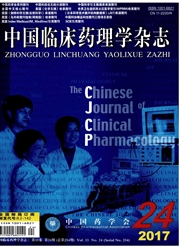

 中文摘要:
中文摘要:
目的 观察神经节苷脂联合康复训练对脊髓损伤患者炎性因子及神经功能恢复的影响。方法 将86例脊髓损伤患者随机分为对照组43例和试验组43例。对照组予以康复训练治疗;试验组在对照组的基础上,予以静脉滴注神经节苷脂20 mg,qd,用药20 d后,停药10 d。2组患者一个周期均为30 d,共治疗2个周期。用酶联免疫吸附法测定血清肿瘤坏死因子-α(TNF-α)、白细胞介素-8(IL-8)和IL-1β水平,用美国脊髓损伤评分标准(ASIA)评价神经功能恢复情况。比较2组患者的临床疗效及不良反应发生率。结果 治疗后,试验组的总有效率为90.70%显著高于对照组的72.09%(P〈0.05)。治疗后,试验组的血清TNF-α、IL-8和IL-1β水平均显著低于对照组(P〈0.01)。治疗后,试验组的运动、痛觉和触觉的ASIA评分均明显高于对照组(P〈0.01)。2组患者不良反应发生率比较差异无统计学意义(P〉0.05)。结论 神经节苷脂联合康复训练治疗脊髓损伤可显著提高临床疗效,降低血清炎性因子表达,有利于神经功能康复,且不增加不良反应的发生率。
 英文摘要:
英文摘要:
Objective To explore the influence of ganglioside combined with rehabilitation training on inflammatory eytokines and neurological recovery in patients with spinal cord injury (SCI). Methods Eighty - six patients with SCI were randomly divided into control group (n = 43 ) and treatment group (n = 43 ) . Control group was only received rehabilitation training. Treatment group was treated with ganglioside 20 rag, qd for 20 d, then discontinuation for 10 d, on the basis of control group. Two groups were treated for 2 cycles, each was 30 d. The levels of serum tumor necrosis factor alpha (TNF -c t), interleukin -8 (IL- 8 ) and IL- 113 were determined by enzyme -linked immuno sor- bent assay (ELISA), the neurological recovery was evaluated by Ameri- can Spinal Injury Association (ASIA). The clinical efficacy and the inci- dence of adverse drug reactions were compared between two groups. Results After treatment, the total effective rate in treatment group was higher than that in control group with significant difference (90. 70% vs 72. 09 %, P 〈 0. 05 ). After treatment, the levels of TNF - α, IL - 8 and IL- 113 in treatment group were significantly lower than those in control group (P 〈 0.01). The ASIA scores of motion, pain and touch in treatment group were higher than those of control group ( P 〈 0. 01 ). There was no significant difference in the incidence of adverse drug reactions between two groups (P 〉 0. 05 ). Conclusion Ganglioside combined with rehabilitation training has a definitive clinical efficacy for the treatment of SCI, which can reduce the expression of serum inflammatory factors and improve the neurological recovery, without increasing the incidence of adverse drug reactions.
 同期刊论文项目
同期刊论文项目
 同项目期刊论文
同项目期刊论文
 期刊信息
期刊信息
